Introduction to Photography:
This guide will introduce you to some key photographic concepts and visual elements to help you get started on your journey with photography. Some of the topics, such as shutter and aperture, address the core mechanical operations of the camera, while others, such as street photography and portraiture, address styles, genres, and conventions of photographing. Ultimately, these categories and tips should serve as a starting point for your own exploration. Pay attention to the photographs you see online, in books, or in magazines, and learn what types of images get you inspired. We encourage you to experiment with your camera and subjects to find a style of photography that feels unique to you!
Contents:
1. Photographic elements
a. Shutter
b. Aperture
c. Color versus black-and-white
2. Photographic approaches
a. Posed versus candid
b. Street photography and ‘the decisive moment’
c. Staged photography
3. Types of photographs
a. Portraiture
b. Landscape
c. Still life and object
4. Visual principles and glossary
a. Framing and the Rule of Thirds
b. Contrast
c. Scale and perception
d. Balance
1a. Shutter
The shutter controls how long the camera’s sensor or film is exposed to the subject in front of the lens. In other words, the shutter helps determine how much light enters the camera. Shutter speeds are described in fractions of a second (or in full seconds, for very long exposures).
Shutter also controls motion or blur. A shutter speed of 1/60 of a second is considered the maximum shutter time you can use and still get a sharp image in most situations. A fast shutter, such as 1/1000 of a second, can be useful on very sunny days or when you want to take a sharp picture of a fast-moving object, like a car. A slow shutter, such as 1/2 second, will allow you to get a good exposure in a dark setting, but will create a blurry image in most brighter settings, unless the camera is mounted on a stable tripod and the subject is not moving.
This picture was snapped while the basketball was in mid-air. The photographer used a fast shutter speed to create a sharp image of the moving players and ball.
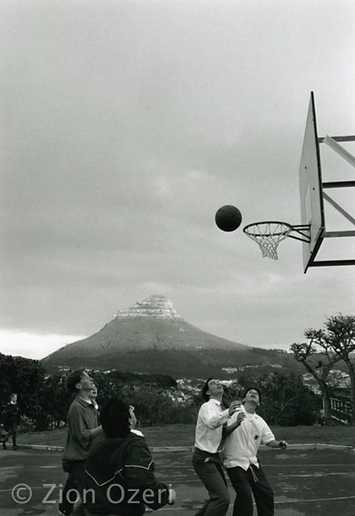
Hertzliya Day School, Cape Town, South Africa, 1998 © Zion Ozeri
1b. Aperture
”Aperture” is a fancy word used to describe the opening in the camera’s lens. The aperture is another element that controls how much light reaches the camera’s sensor or film.
The aperture’s setting is described as its ‘F-stop’. When the aperture is large, more light can enter the camera, allowing you to use a quicker shutter speed. A small aperture constricts light, so you will need to make up for this with a slower shutter speed. It is important to keep in mind that smaller aperture numbers such as ‘F/2’ describe larger aperture openings, and larger numberssuch as ‘F/16’ describe smaller aperture openings.
Aperture also controls the “depth of field,” which describes how much of the picture is in focus. Depth of field can be described as shallow, meaning only part of the picture is in focus, or deep, meaning all or most of the picture is in focus.
In the picture below, there is a shallow depth of field. The boy in the front part of the image is in sharp focus. The boy behind him, because he is farther away from the camera, is slightly blurry. In the far distance, the landscape is almost totally blurry. Photographers use a small aperture to get a shallow depth of field. This is especially useful for portraits, so that the subject is in focus, but their surroundings are blurred.
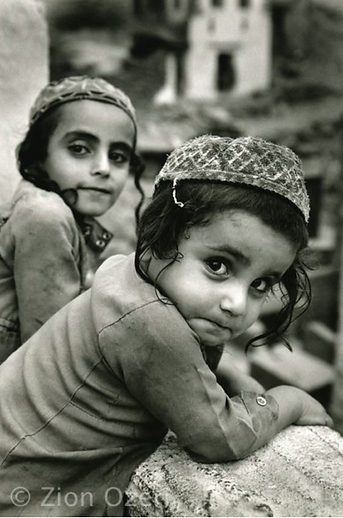
Haidan A-Sham, Yemen, 1992 © Zion Ozeri
1c. Color versus Black-and-White
The choice of color or black-and-white may depend on many factors, including what you want to convey about your subjects. For example, you might want to show someone’s colorful clothing, or a blue sky. Color images portray the world close to how we see it in real life and can feel more contemporary. On the other hand, color can sometimes be distracting, or it might not suit the mood you seek to convey in your photographs. Black-and-white images highlight shape and light, and are often associated with a more classic, historical, or serious mood.
As an exercise, compare some of your own photographs in color versus black-and-white. See what kinds of images you prefer in each style.

The Jewish Cemetery, Yangon, Myanmar, 2017 © Zion Ozeri
Color works well in this image, as there are a variety of natural tones that look harmonious together. The red of the woman’s skirt provides a subtle contrast that makes her stand out against the green vegetation. The colors are not distracting, and they contribute to the overall mood of the image.

The Jewish Cemetery, Yangon, Myanmar, 2017 © Zion Ozeri
In black-and-white there is no dominant form that stands out, so it is hard for our eyes to pick a point on which to focus. Without color, the textures and patterns of the trees, the fabric of the woman’s clothing, and the old stone markers can seem overwhelming as they compete for our gaze.
2a. Posed versus Candid
A posed photograph is one in which the photographer has positioned or given instructions to thesubject. A photograph with objects but no people can also be considered posed. A candid photograph is one taken of subjects in their natural positions and settings without any posing. Because of this, the subject usually does not look at the camera in a candid photograph. Posed and candid pictures can both be seen across many types, genres, or categories of photography.

Farmers, Greenville, Mississippi, USA, 2008 © Zion Ozeri

Morning Study, The Bronx, New York, USA, 1985 © Zion Ozeri
The photograph on the left has been posed, while the one on the right is candid.
2b. Street Photography and the “Decisive Moment”
Street photography is an approach to picture-taking in public spaces that is candid and often quick or spontaneous. Street photography is similar to (and may overlap with) documentary photography and photojournalism. Some famous street photographers include Robert Frank, Gary Winogrand, Lee Friedlander, and Helen Levitt.
Closely associated with street photography, the term “decisive moment” comes from the title of a book published in 1952 by the French photographer Henri Cartier-Bresson. This term has come to describe unplanned, well-composed images taken at just the right moment. Unique to photography, the decisive moment draws upon photography’s ability to freeze time and capture a split second of a quick-moving, fleeting scene.
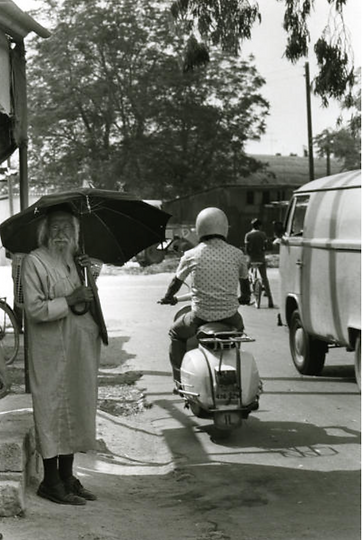
In Passing, Rosh Ha’ayin, Israel, 1984 © Zion Ozeri
In this moment, the photographer captured the contrast between the old way of life and the new. The older man to the left, wearing traditional clothing and moving by foot, looks at the camerajust as another man, in modern clothing, zips by on a motorbike.
2c. Staged Photography
Staged photography is a type of posed photography that includes constructed settings and arranged figures. It can depict imagined or fictional events or capture artificially created scenarios. There are many different styles of staged photography, and it encompasses various types of fine art or fashion photography. Famous photographers who create staged images include Gregory Crewdson, Laurie Simmons, Carrie Mae Weems, and Annie Liebovitz.
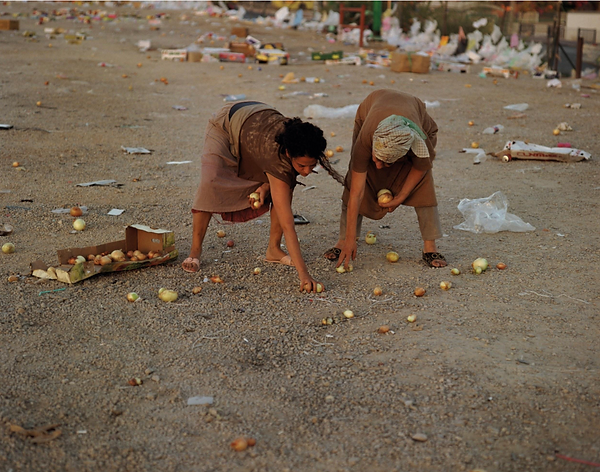
Adi Nes, Untitled (Ruth and Naomi) from the series “Biblical Stories”
Adi Nes' staged photographs allude to biblical stories, and the subjects in his images are given the names of biblical figures. In the photograph Untitled (Ruth and Naomi), Nes has staged two actors to look like people at the margins of Israeli society. Through this approach, Nes links the biblical story of Ruth and Naomi to today’s poverty.
3a. Portraiture
A great portrait goes beyond simply documenting a person’s appearance. It captures something essential about the subject. When you take a portrait, think about why you have chosen to photograph this particular person. What do you want to show through your image? Do you want to represent a specific aspect of that person’s identity? Pay attention to the emotion expressed through your subject’s facial expression or posture. Also consider the setting of your photograph, and how the lighting affects your subject’s appearance. These are just a few of many factors that will help determine whether your portrait successfully captures the essence of your subject.

Park Ranger, Acadia National Park, Maine, USA, 2005 © Zion Ozeri
In this photograph, we see a man sitting at a high elevation overlooking a dramatic natural landscape. He looks straight into the camera and seems at ease in his environment. From his badge and uniform, as well as from his setting, we can tell that he is a park ranger. This image is a good example of environmental portraiture. An environmental portrait depicts the subject against a background in which he or she feels comfortable or can regularly be found, such as at work, at school, at home, or partaking in a hobby.
Who do you think chose this setting – the photographer or the subject? Why? What can we learn from this man’s facial expression and posture? What else might we be able to guess about this man from what we see in the photograph?
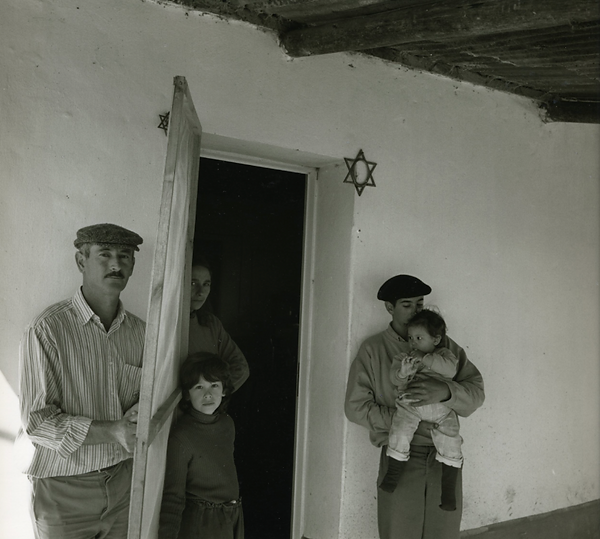
Caretaker and Family, Basavilbaso, Argentina, 2002. © Zion Ozeri
What might you be able to tell about the personalities of each person in this photograph? Do you think the photographer knows this family well? Why or why not? Where do you think this photograph is set? Where was the photographer standing when he took this picture?
3b. Landscape
When photographing a landscape, it’s important to think about your goals. What compels you to photograph this particular scene? What are you trying to communicate? How would you like your viewers to feel in response to seeing your photograph? How does the mood change if you include or exclude various people or objects? Other factors to consider when taking landscape photographs include:
- The vantage point from which the photograph is taken
- The location of the horizon line
- Which elements appear in the image’s foreground, middle ground, and background
- The lighting, time of day, and weather conditions in the scene

Buffalo, Yellowstone, Wyoming, USA, 1996 © Zion Ozeri
Five buffalo occupy the foreground of this image, drawing attention as the key subject matter. They stand out as dark objects amongst a white, snowy scene. In the middle ground we see a thin, meandering river and a singular tree. In this image, the river functions like the horizon line. In the background we see a mountainside covered with thin, straight trees; however, it is largely obscured by a heavy fog. The photograph makes us feel as if we are given a special glimpse at the buffalo quietly grazing in their natural habitat, which is made more dramatic by the harsh winter conditions.
3c. Still Life and Object
”Still life” typically refers to a formal or purposeful arrangement of objects – though there are many situations in which a photographer may choose to photograph objects, either posed or encountered. Photographs of objects can be particularly effective in series or groups of images in which they give important context or contribute to a larger narrative. In some ways, a still life is like a portrait of something inanimate.
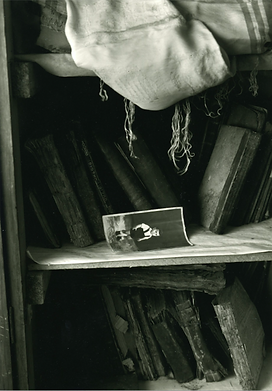
Bookcase, Plovdiv, Bulgaria, 2000 © Zion Ozeri
At the center of this photograph, we see a picture of a young boy. From the curled paper and the clothing on the boy, we can tell that this is an old print of a photograph taken long ago. We can see the image fairly well, though it is not presented to us upright and frontally. Behind the photograph and on the shelves below are many tattered books that look worn with age. There is a great deal of texture visible in their frayed pages and degrading spines. A tallis hangs over the top shelf, with tzitzit delicately draping down towards the picture. The soft lighting on the picture, books, and tallis contributes to a mood that is nostalgic and somber.
4a. Framing and the Rule of Thirds
The Rule of Thirds is a technique used by photographers to help frame a composition. It is more of a trick or guide than a rule. Ultimately, how you frame your photographs is your choice!
The Rule of Thirds is a grid of 9 boxes that you can imagine sitting on top of the picture plane. It looks something like this:
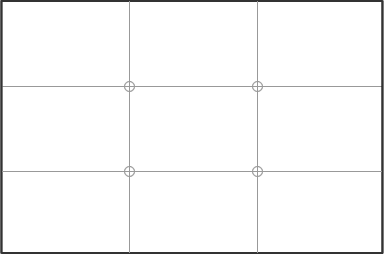
Placing your subject or key focal point near a spot where two of the lines intersect is considered a good way to frame your image. The idea is to avoid always placing your subject in the center of the grid or the horizon line across the middle of the picture.
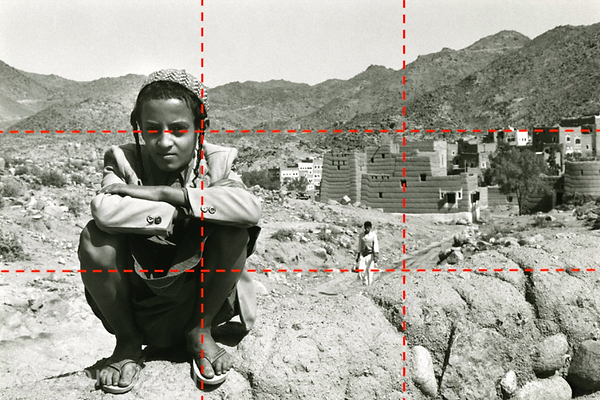
Sagin, Yemen, 1992 © Zion Ozeri
4b. Contrast
Contrast means “difference” and it generally refers to the way a photographer uses light and dark tones in a photograph.
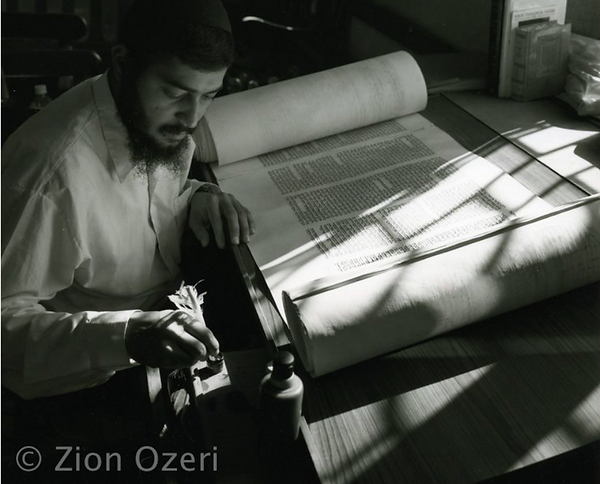
Scribe, Mumbai, India, 2001 © Zion Ozeri
This image uses the contrast between light and dark to emphasize the main subjects of the image: the man and the Torah. Natural light pours in from a window to the right, which is just out of the frame. The Torah appears particularly bright, adding to its symbolic significance in the image. There is a strong contrast between the foreground, which appears bright, and background, which appears dark. This lighting strategy encourages the viewer to focus on the man and the Torah without getting distracted by other elements in the room.
4c. Scale and Perception
The vantage point from which you take a photograph can have a strong impact on the effect of the work. For example, instead of simply taking a picture from eye level, you might get a more interesting image from up high (perhaps standing on a chair) or from below (perhaps lying on the floor), from far away or close up. Pay attention to how your vantage point affects your perception of people and objects. You should also consider how much of the frame is occupied by different elements, as well as the spatial relationship between these elements. Does something in your picture look unexpectedly small or big? How might you change this or use it to your advantage? One of the most important tools photographers have is their feet! Try out new or unexpected angles by moving around your subject.
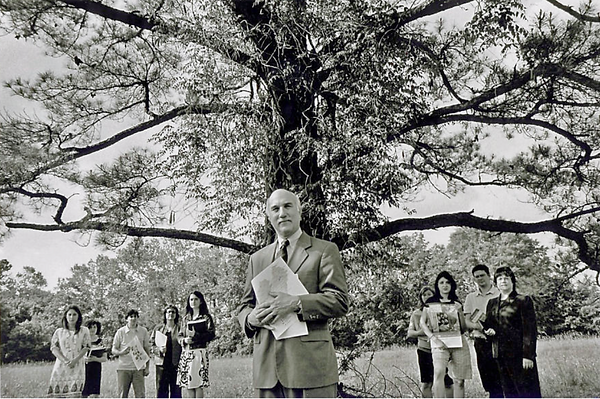
Institute for Southern Jewish Life, Jackson, Mississippi, USA, 2008 © Zion Ozeri
This photograph is taken from a low angle, so that the central figure looks tall and confident. Despite this, the top of his head only comes to the halfway point in the frame. The rest of the frame is occupied by a large tree, whose sturdy-looking trunk frames the man. The branches also frame the other individuals in the photograph. Because these individuals are set further back in the photograph, they appear smaller. This gives us the sense that the central man is a leader amongst the group.
4d. Balance
Balance refers to the way the elements of a photograph are distributed throughout the composition and how they relate to each other.
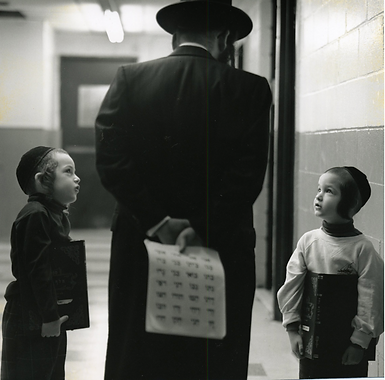
Hallway, Brooklyn, New York, USA, 1996 © Zion Ozeri
In this image we see a man talking to two children. We can tell that the photographer bent downso that the image was taken at about the height of the little boys. The top of the man’s hat is slightly cut off by the top of the frame, and the boy’s faces are at the midline. How does this angle affect your perception of the figures in the image?
The taller adult is in the middle of the composition, which is balanced with one boy on each side. This balance is further emphasized by the square frame of the photograph. The boy to the right is slightly shorter, though this is visually balanced by the man leaning towards his direction. What part of the photograph do you look at first? How do your eyes move around the picture? What elements do you notice first, then second, and so on? What direction do your eyes move? What shapes or lines you see in the image? If you look for a few moments, do you notice anything about the photograph or its framing that you didn’t see at first?
THE LAB: DECOY | 6 Photographers 1 Man - A Portrait Photography Session With A Twist